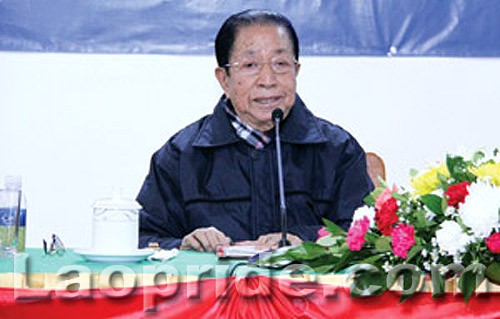Sisavath Keobounphanh speaks on legacy of Lao army
to mark 65th anniversary

The Lao People's Army has changed dramatically over the years and has grown into a more modern, stronger force under the guidance of its leaders, including President of Laos Kaysone Phomvihane.
General Sisavath Keobouphanh gave a speech about the legacy of the army in Vientiane yesterday, ahead of the army's upcoming 65th anniversary on January 20, 2014.
About 500 senior officials from the Ministry of Information, Culture and Tourism gathered in the National Culture Hall to listen to the speech.
General Sisavath was also once a member of the Politburo and a former President of the Lao Front for National Construction.
His speech covered the history of the Lao army, from its inception as the Lao Issara in 1949 to the Lao People's Army today.
He told the audience that he and President Kaysone fought in the Lao Issara's Latsavong unit after he received an order from the Indochina Communist Party President at the time, Ho Chi Minh.
“Latsavong Army Unit was set up in January 20, 1949 and I was one of soldiers in this unit,” he said.
President Kaysone told his soldiers they must fight bravely and do well by their country by liberating it from foreign aggressors.
The Indochina Communist Party was ordering Vietnamese solders to fight with the French at the time, at Dien Bien Fu in Vietnam.
When the French forces were defeated at Dien Bien Fu and had no reinforcements in the area they were forced to grant independence to Indochina, Vietnam, Laos and Cambodia.
The independence of Vietnam, Laos and Cambodia was confirmed and accepted at a meeting in Geneva in 1949.
It was while Vietnamese volunteer solders were returning to their own country and the Lao army was recouping in Xamneua and Phongsaly provinces that Laos was attacked again, this time by America.
“This time Laos was facing the biggest enemy, the most fierce and richest in the world, General Sisavath said.
Ho Chi Minh decided to separate the Indochina Communist Party into three parties to fight the aggressor forces.
The Indochina Communist Party became the Vietnam Labour Party, the Cambodian People's Party and the Lao People's Party.
The Vientiane army was aligned with and fighting for the aggressor, and engaged the Lao People's Party soldiers in Xamneua province from the end of 1955 until the end of 1958.
In early 1960 aggressor forces captured several Lao leaders and locked them in Phonkheng jail, and used its forces to blockade two battalions at the Plain of Jars and in the Xiengngeun area.
But all the Lao leaders and t he two battalions were eventually able to escape and rejoin the fight. The soldiers of the Lao People's Army fought countless battles before eventually achieving victory and liberating the nation in 1975.


 Pages: 1
Pages: 1
 Pages: 1
Pages: 1
 Home
Home




